Konfrontationen 2019 - Soundart 19
soundart 2019: SOMETHING TO PLAY / ETWAS ZUM SPIELEN
Liner notes (EN) Liner notes (DE)
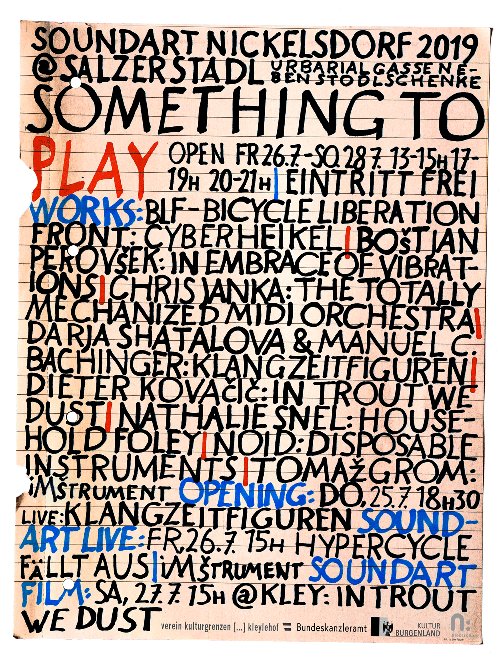
@ Salzerstadl / 2425 Nickelsdorf, Urbarialgasse neben der "Stodlschenke"
open: fr 26.7.-so 28.7. 13-15h, 17-19h, 20-21h
opening: do, 25.7. 18h30
KLANGZEITFIGUREN
soundart live: fr 26.7. 15h
HYPERCYCLE FÄLLT AUS, iMstrument
soundart film: sa, ab 15h @ kleylehof
IN TROUT WE DUST
Supported by



& verein kulturgrenzen [...] kleylehof
<< Composing means building an instrument. >>
[Helmut Lachenmann, Musik als existenzielle Erfahrung] ⤫
Every age has its particular forms of making music and develops new instruments based on current technologies and concepts.
New ways to make music, new genres and compositional styles and new instruments are interrelated. The distinction between the terms "musical instrument", "score" and "composition" is becoming more and more questionable not only since the exemplary work of Steve Reich: "Pendulum Music" (1968).
Nothing new about that. What is new, however, is the creative insolence, a playfulness in handling the technological possibilities – the appropriation of arbitrary objects, which are blatantly declared musical instruments. What is new is a so-do-as-if, a provisional character not to be confused with arbitrariness: meta-instruments that consist of set pieces of performances; traditional instruments that are used consistently against the grain; modular instruments that can be put together as required.
All this are statements of a radical appropriation and transformations of reality. They reflect the dissolution of a universally recognized set of values for art and society by countering with a self defined narrative, a guide to creatively deal with the new realities.
Statements of appropriation, of original decision making, transformation and redefinition, which do not consent given realities, but rather contrast them with their own constructions.
This are – according to Buckminster Fuller – machines with "built-in missing user manual"
<< Komponieren heißt: ein Instrument bauen. >>
[Helmut Lachenmann, Musik als existenzielle Erfahrung] ⤫
Jede Zeit bringt ihre eigenen Formen des Musikmachens hevor und entwickelt dazu neue Instrumente, die auf jeweils aktuelle Technologien und Konzepte basieren.
Neue Arten Musik zu machen, neue Genres oder Kompositionsarten und neue Instrumente bedingen einander gegenseitig. Die Sinnhaftigkeit der Unterscheidung zwischen den Begriffen"Musikinstrument", "Partitur" und "Komposition" ist spätestens seit dem beispielhaften Werk von Steve Reich: "Pendulum Music" (1968) in Frage gestellt.
Das alles ist nicht neu. Neu ist aber die kreative Unverfrorenheit, der spielerische Umgang mit den technologischen Möglichkeiten und das Sich-Aneignen von beliebigen Gegenständen, die kurzerhand zu Musikinstrumenten erklärt werden. Neu ist ein So-tun-als-ob, eine Vorläufigkeit, die nicht mit Beliebigkeit zu verwechseln ist: Meta-Instrumente, die aus Versatzstücken von Performances bestehen; traditionelle Instrumente, die konsequent gegen den Strich verwendet werden; modulare Instrumente, die sich nach Bedarf beliebig zusammenstellen lassen.
Das alles sind Statements einer radikalen Aneignung sowie einer Umgestaltung der Realität. Sie spiegeln die Auflösung eines allgemein anerkannten Wertekanons von Kunst und Gesellschaft wieder indem sie diesem ein Narrativ, eine Anleitung, zum kreativen Umgang mit den neuen Realitäten entgegensetzen.
Es sind Statements der Aneignung, des Selbst-Entscheidens, der Umgestaltung und der Neudefinition, die sich nicht mit den vorgefundenen Realitäten abfindet, sondern eigene Konstruktionen dagegensetzt.
Es sind – frei nach Buckminster Fuller – Maschinen mit "eingebauter fehlender Bedienungsanleitung"
BLF - Bicycle Liberation Front ⤫
CYBERHEIKEL
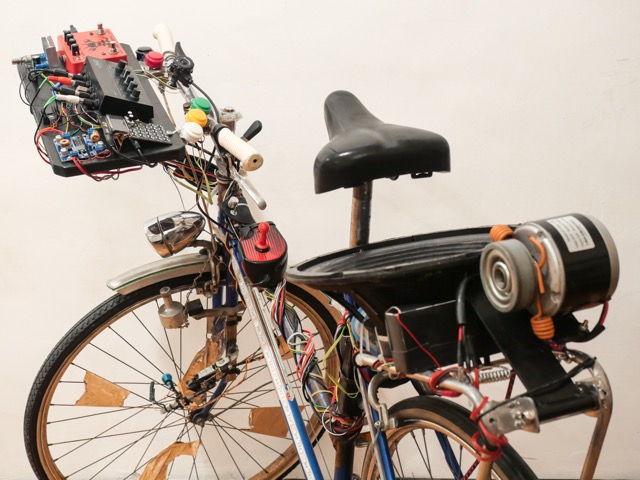
[Chris Veigl, Conny Zenk, Dominik Painsi, Elena Tiis, Kaiserin Sissi, Uli Kühn, Stefan Voglsinger, selbsthilfefahrradwerkstatt goldschlaggasse wien]
"But I still believe that the spirit of the bicycle, in along with love, is most evenly distributed in the world."
[mindi monumentana, tempo lectri #14, 3'50'', okto, 2oo9]
CYBERHEIKELS: permanent interactive performance
Cyberheikel is the electro-acoustic connection of the soundart exhibition and the jazz gallery Nickelsdorf.
The vehicles are dynamo-powered sound generators who accompany visitors between the locations as part of the confrontations.
HYPERCYCLE FÄLLT AUS is an immersive audiovisual bike performance, featuring noise, tekkno, sound art, mindmachines and DIY.
"aber ich glaube immer noch, dass der geist des fahrrads neben der liebe das ist, was in der welt am besten verteilt ist."
Interaktive Dauerperformance: CYBERHEIKELS
Cyberheikel ist die elektroaktustische Verbindung der Soundart Ausstellung und der Jazzgallerie Nickelsdorf.
Die Vehikel sind dynamobetriebene autake Klangerzeuger die im Rahmen der Konfrontationen BesucherInnen zwischen den Orten begleiten.
HYPERCYCLE FÄLLT AUS ist eine immersive audiovisuelle Fahrradperformance, die Noise, Tekkno, Klangkunst, Mindmachines und DIY verschmelzen lässt.
bikekitchen hypercycle
Biographies:
Boštjan Perovšek ⤫
IN EMBRACE OF VIBRATIONS
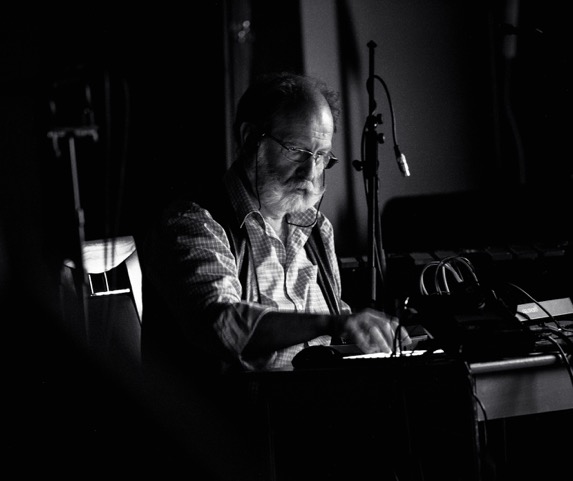
Boštjan Perovšek: "In the embrace of vibrations (V objemu vibracij)" electroacoustic project
In "In the embrace of vibrations" (V objemu vibracij), Perovšek works with concrete sound, mostly the sound of insects and spiders in which he finds a special vibrating energy. WIth electroacoustic treatment the sounds are worked into short sound modules - minimalistic compositions. Based on this and the second source of material – electronic sound modules with very similar structure – he constructs larger structures, interweaving (combining) them in a process of electroacoustic composition.
Because of the similarity of this two sources, an interesting sound mass is generated, for which we often do not know if we listen to pure electronics, pure natural sounds, or the synthesis of one and the other.
For Nickelsdorf a special 4-channel remix for megaphones is made to adapt the composition for an open air sound installation.
With this project, Boštjan Perovšek continues his work in the field of combining art and science, which he started already in the 1980s.
"In the embrace of vibrations" was first realized at the Sajeta festival 2019 as an 4-channel audio installation. The installation also contains elements from the composition "Pavilion For Spiders Sound Tour", which was performed on May 8, 2019 at the opening of the pavilion "Spider / Web Pavilion 7 - Studio Tomás Saraceno" at "Biennale Arte 2019 - La Biennale di Venezia".
The sounds of spiders were recorded in 2018, in Tomás Saraceno Studio in Berlin.
In "In the embrace of vibrations" (V objemu vibracij) arbeitet Perovšek mit konkretem Klänge, meist dem Klang von Insekten und Spinnen, in denen er eine besondere, vibrierende Energie hört. Mit elektroakustischen Werkzeugen werden diese Klänge zu kurzen Klangmodulen verarbeitet - minimalistischen Kompositionen. Darauf aufbauend und mit rein elektronisch generierten Klangmodulen als zweite Materialquelle, konstruiert er größere Strukturen, die er in einem elektroakustischen Kompositionsprozess verwebt (kombiniert).
Aufgrund der Ähnlichkeit dieser beiden Quellen entsteht eine interessante Klangmasse, bei der der Rezipient oft nicht wissen kann, ob es sich um reine Elektronik, reine Naturgeräusche oder die Synthese der beiden Elemente handelt.
Für Nickelsdorf wird ein spezieller 4-Kanal-Remix für Megaphone erstellt, um die Komposition an die Gegebenheiten der Open-Air-Sound-Installation zu adaptieren.
Mit diesem Projekt setzt Boštjan Perovšek seine bereits in den 1980er Jahren begonnene Arbeit auf dem Gebiet der Verbindung von Kunst und Wissenschaft fort. "In the embrace of vibrations" wurde beim Sajeta-Festival 2019 erstmals als 4-Kanal-Audio-Installation realisiert.
Die Installation enthält auch Elemente aus der Komposition "Pavilion For Spiders Sound Tour", die am 8. Mai 2019 anlässlich der Eröffnung des Pavillons "Spider / Web Pavilion 7 - Studio Tomás Saraceno" auf der "Biennale Arte 2019 - La Biennale di Venezia" aufgeführt wurde.
Die Klänge von Spinnen wurden 2018 im Tomás Saraceno Studio in Berlin aufgenommen.
Boštjan Perovšek Biography
Chris Janka ⤫
THE TOTALLY MECHANIZED MIDI ORCHESTRA
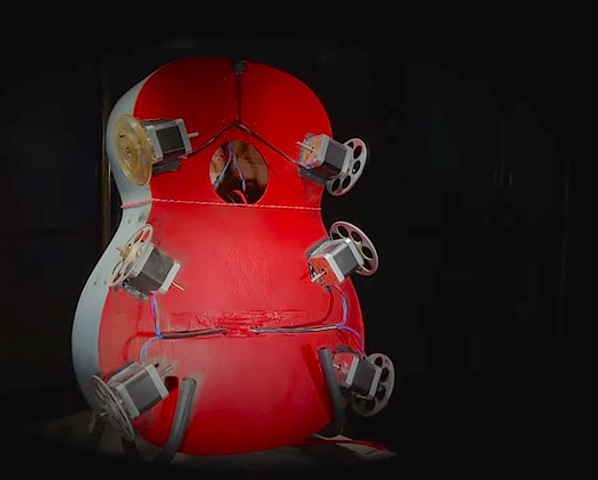
The T.M.M.O. is an orchestra of approximately 100 'musicians'. Made of engines, relays, electromagnets and pneumatic components. It can interpret any midi file in its own unique way. The 'musicians' are not represented by robots playing conventional instruments, but various sound generators that are aware of their mechanical origin.
MIDI stands for 'musical instrument digital interface', a protocol for digital music programming that was developed in the early 1980s and is still today the industry standard. Criticism says that it sounds too mechanical and programmed, and thus, so called 'humanising' algorithms were introduced, in order to give the programmed material a certain 'human' inaccuracy.
By reproducing the purely digitally programmed midi files with analogue – inaccurate – robots, the midi files' specified precision is 'humanized' in a purely mechanical way, in this case 'mechanized'.
In an increasingly digitized world, it has become more and more important to experience haptic moments. The Total Mechanized Midi Orchestra transforms a masterpiece of digitization – MIDI – making it tangible and perceptible.
Das T.M.M.O. ist ein bis zu 100 "Köpfiges" Orchester, gebaut aus Motoren, Relaise, Elektromagneten und pneumatischen Bauteilen, das jedes beliebige Midifile auf seine Weise interpretieren kann. Die 'MusikerInnen' sind aber nicht einfach von Robotern bediente konventionelle Instrumente, sondern Klangerzeuger die sich ihrer mechanischen Herkunft bewusst sind.
MIDI steht für "Musical Instrument Digital Interface" und ist ein Protokoll zur Musikprogrammierung das Anfang der 80`er Jahre entwickelt wurde und bis heute Standard ist. Als Kritiken laut wurden, das alles klänge viel zu mechanisch und programmiert, wurden sogenannte "humanising"- Algorithmen eingeführt um dem Programmiertem wieder eine gewisse "menschliche" Ungenauigkeit zu verpassen.
Durch die Wiedergabe des rein digital programmierten Midifiles durch analog-ungenaue Roboter wird die vorgegebene Exaktheit auf rein mechanischem Wege humanisiert- in diesem Falle "mechanisiert".
In einer immer digitalisierteren Welt werden haptische Momente immer bedeutender. Das T.M.M.O. transformiert einen Meilenstein der Digitalisierung, MIDI, und macht sie damit spür- und erlebbar.
Darja Shatalova & Manuel Cyrill Bachinger ⤫
KLANGZEITFIGUREN
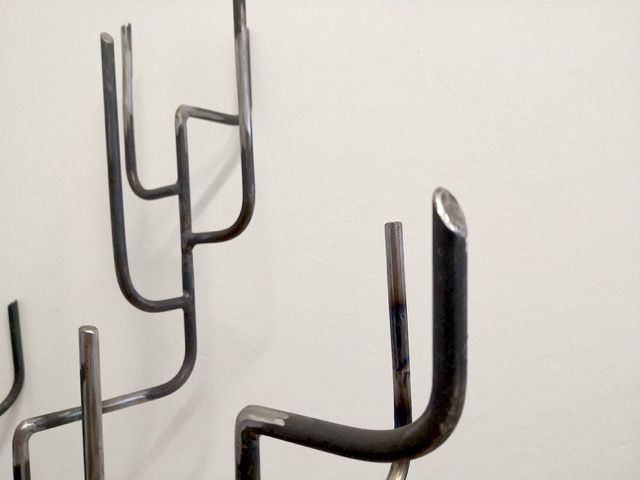
"KLANGZEITFIGUREN" represent a conceptual work by Darja Shatalova dealing with the spatialization of time. The objects, welded from round steel went through different phases of reformation and translocation. They are brought to sound in a performative setting with Manuel Cyrill Bachinger and Darja Shatalova by playing them with hands and a cello bow. The sound performance transforms the time - conceptually and materially inscribed in the figures - into sound.
"KLANGZEITFIGUREN" ist eine konzeptionelle Arbeit, die sich mit der Verräumlichung von Zeit beschäftigt. Die aus Rundstahl geschweißten Objekte haben dabei bereits verschiedene Phasen des Wandel durchlaufen. In einem performativen Setting werden sie von Manuel Cyrill Bachinger und Darja Shatalova zum Klingen gebracht, indem sie mit den Händen oder einem Cellobogen gespielt werden. Die Soundperformance wandelt die in den Figuren konzeptuell und materiell eingeschriebene Zeit in Klang um.
Biographies:
Dieter Kovačič ⤫
IN TROUT WE DUST (film)
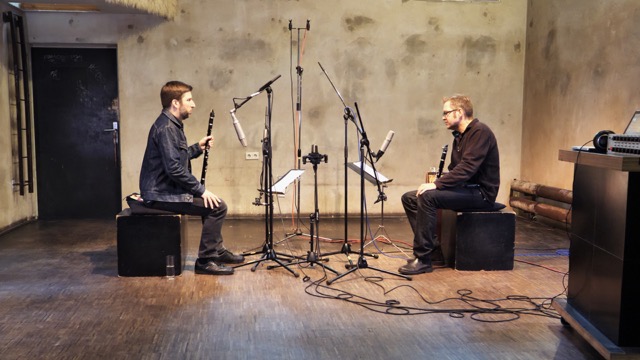
A film about the international nothing.
"In Trout We Dust" explores the world of the Berlin clarinet duo "The International Nothing" around the creation and release of the album "In Doubt We Trust". Vienna-based musician and filmmaker Dieter Kovačič has accompanied the two musicians Kai Fagaschinski and Michael Thieke for more than a year, in the rehearsal room and on recordings as well as on tour. In the film he asks how and why Kai Fagaschinski and Michael Thieke have been working on their distinctive sound for almost 20 years, giving the music the space and time it needs to make its voice heard, spreading light on the aesthetic and social environment of the duo. Side characters are staring French streets, Berlin rooftops and Swiss cooking pots.
idea & realisation: Dieter Kovačič 2019
Kamera: Dieter Kovačič, Billy Roisz
Festivalpremiere: Diagonale, Festival d. Öst. Films
Distribution: sixpackfilm
Ein Film über das internationale Nichts.
"In Trout We Dust" erforscht die Welt des Berliner Klarinettenduos "The International Nothing" rund um die Entstehung und Veröffentlichung des Albums "In Doubt We Trust".
Dieter Kovačič, Musiker und Filmemacher aus Wien, hat die beiden Musiker Kai Fagaschinski und Michael Thieke über ein Jahr lang begleitet, im Proberaum und bei den Plattenaufnahmen genauso wie auf Tour. Er stellt in dem Film die Frage wie und warum Kai Fagaschinski und Michael Thieke seit bald 20 Jahren an ihrem markanten Sound tüfteln, gibt der Musik den Raum und die Zeit die sie braucht um sich Gehör zu verschaffen und beleuchtet das ästhetische und soziale Umfeld des Duos. In weiteren Rollen sind französische Straßen, berliner Dächer und eidgenössische Kochtöpfe zu sehen.
Nathalie Snel ⤫
HOUSEHOLD FOLEY The Shining PARALLEL SOUNDTRACK
(Nathalie Snel, 2019)
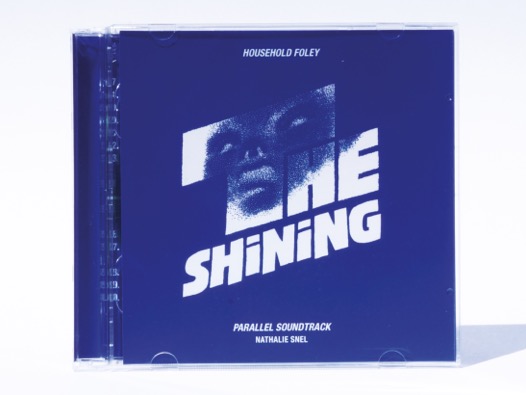
For this work, Snel remade the musical score of Stanley Kubrick's film 'The Shining' (1980) in her home using everyday household objects. The new soundtrack lasts 146 minutes and can be played in sync with the film to replace the original score.
'The Shining' is set in the Overlook Hotel, a holiday resort in Colorado which was built on top of a Native American burial ground. Jack Torrance, an aspiring writer, is hired as the winter caretaker and moves into the hotel with his wife and son for the season. Already before the Torrances arrive at the Overlook Hotel, Jacks son Danny begins to experience flashes from scenes of a murder that took place there in the past. As Jack is told during his job interview, years back the caretaker of the hotel killed his wife and two daughters with an axe.
Despite the use of flatness in the story line and characters, 'The Shining' is not your regular horror film. The movie has a layered complexity in which the viewer is given ample time and space rather than pulled into an avalanche of shocks. The empty hotel becomes an echo chamber of resemblances and repetitions in which past and present seem to fold into each other. More than fear it is a sense of uncanny eeriness that lends the film its disturbing quality.
The haunting of the Overlook Hotel can be read as the return of a repressed colonial history of the USA. By re-recording the soundtrack in her apartment, Snel broadens this resurfacing to the context of her home in Europe today.
Für diese Arbeit hat Snel den Soundtrack von Stanley Kubricks Film "The Shining" (1980) in ihrem Haus mit alltäglichen Haushaltsgegenständen nachgespielt. Der neue Soundtrack dauert 146 Minuten und kann synchron zum Film abgespielt werden, er ersetzt die originale Tonspur.
"The Shining" spielt im Overlook Hotel, einem Ferienresort in Colorado, das auf einem Gräberfeld amerikanischer Ureinwohner erbaut wurde. Jack Torrance, ein aufstrebender Schriftsteller, wird als Winterpfleger engagiert und zieht mit seiner Frau und seinem Sohn für die Saison in das Hotel. Schon bevor die Familie Torrance im Overlook Hotel ankommen, hat Jacks Sohn Danny Visionen eines Mordes; wie Jack während seines Vorstellungsgesprächs erzählt wird, hat der Hausmeister des Hotels vor Jahren seine Frau und zwei Töchter mit einer Axt getötet.
Trotz seiner einfachen Handlung und den flachen Charakteren ist "The Shining" kein regulärer Horrorfilm, er hat vielmehr eine vielschichtige Komplexität, die dem Zuschauer viel Zeit und Raum lässt, anstatt ihn in den Strudel der Ereignisse zu ziehen. Das leere Hotel wird zu einer Echokammer von Ähnlichkeiten und Wiederholungen, in der Vergangenheit und Gegenwart ineinander fließen. Es ist nicht so sehr die blanke Angst, als vielmehr eine unheimliche Grundstimmung, eine sich einschleichende Entfremdung der Figuren von der Realität, die dem Film seine verstörende Qualität verleiht.
Die Heimsuchung des Overlook Hotels kann als Rückkehr einer unterdrückten Kolonialgeschichte der USA verstanden werden. Durch die Neuaufnahme des Soundtracks in ihrer Wohnung erweitert Snel diese Erneuerung auf den Kontext ihrer heutigen Heimat in Europa.
noid ⤫
DISPOSABLE INSTRUMENTS
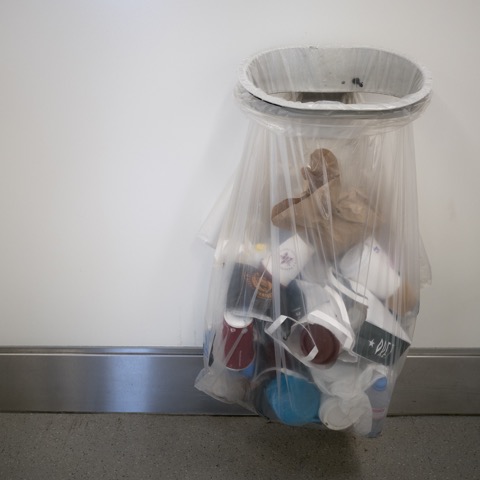
Based on his composition "plastic bag music", noid stages a selection of typical disposable items as musical instruments. A score for each object presents suggestions on how to make music with the unaltered everyday object.
Ausgehend von seiner Komposition "plastic bag music" inszeniert noid eine Auswahl von typischen Wegwerfgegenständen als Musikinstrumente. Jeweils eine Partitur vermittelt Vorschläge wie mit den unveränderten alltäglichen Gegenständen Musik gemacht werden könnte.
Noid
Tomaž Grom ⤫
iMstrument [sound installation & live performance]

iMstrument consists of a collection of recorded audio/video clips, performed by different musicians, improvising individually for a camera. The user can play the iMstrument selecting from this resource, defining volume and randomness, generating a continuous and unrepeatable composition.
iMstrument is a continuously evolving creation, combining original and live music. It is taking place at the intersection of technologically processed contemporary sonority and the and the elementarity of pure instrumental sounds, documented in digital recordings. It is a meeting place of the absent technologically reproduced performers and the immediate presence of the user.
Tomaž Grom: concept, sound recording
Ana Čigon: video recording and editing
Vasja Progar: processing, coding
Tilen Sepič: interface design and production
Sploh institute: production
Špela Trošt: executive producer
iMstrument besteht aus einer Sammlung aufgenommener Audio- Videoclips, die von verschiedenen Musikern einzeln für eine Kamera improvisiert wurden. Der Benutzer kann das iMstrument spielen, indem er aus dieser Sammlung auswählt, Lautstärke und Zufälligkeit definiert und so eine kontinuierliche und nicht wiederholbare Komposition erzeugt.
iMstrument ist ein, sich ständig weiterentwickelndes Projekt, das Original- und Livemusik kombiniert. Es findet statt, an der Schnittstelle von technologisch verarbeiteter zeitgenössischer Klanglichkeit und der Elementarität reiner instrumentaler Klänge, dokumentiert in digitalen Aufnahmen. Es ist ein Treffpunkt der abwesenden technologisch reproduzierten Künstler und der unmittelbaren Anwesenheit des Benutzers.